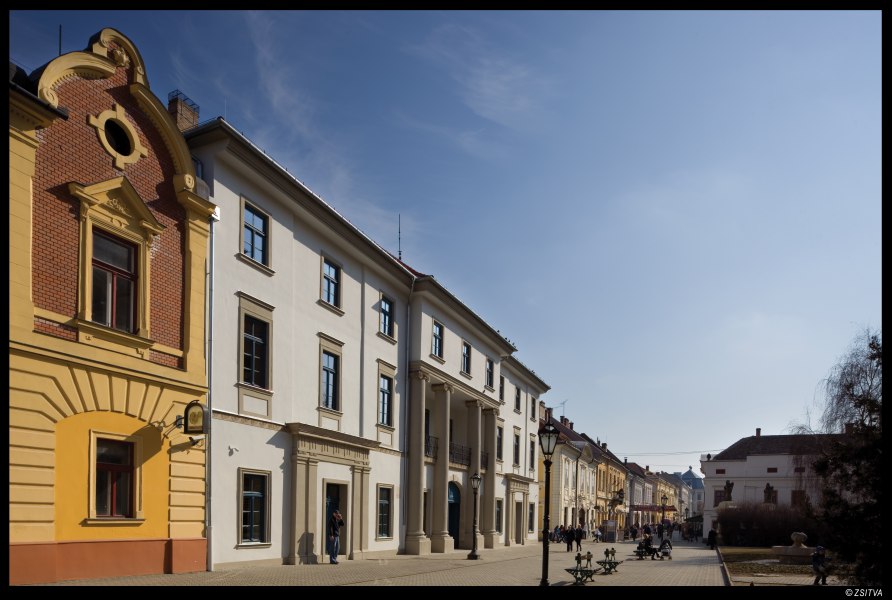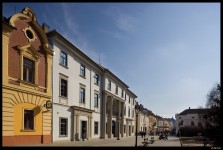Dialogue of Reforming Periods
György Kepes International Art Centre, Eger
Architect: Botos Judith
Text: Szegő György
Photos: Zsitva Tibor, Szegő György
Let us build the future from the past – this could be the motto of the reconstruction of the former Spetz House designed by Judith Botos which is triply true. Firstly, because the house built by Ferenc Povolny embodies the French revolutionary architecture in the „characteristical.ly Hungarian flourishing” of Classicism. Secondly, because the previous reconstruction managed by Rudolf Janesch (1979-83) resulted in an architecture that has mainly turned into architectural history by now. And thirdly, because the new visual language that Kepes and Moholy-Nagy sketched 65 years ago in Chicago still remains a beautiful vision and a promise of the future rather than reality.
The fate of the house is a romantic one: Spetz pharmacist moved here the Jesuit pharmacy in 1802, in 1812 he built a candy factory at the back of the lot, in 1823 Déryné lived here and the house functioned as a theatre hall, in 1827 it burned down, then Spetz added an attic-level which was destroyed during the reconstruction. This is how the house came to be the home of the old casino of Eger after 1833. Whilst retaining its function, it came into the possession of the canon of the town and also housed the county archives from the early 20th century on. Since 1951 it functioned as the trade unions centre, from 1983 the newly covered court was the heart of the house of arts and the youth house where theatre performances are held once again. According to the concept by Rudolf Janesch the rodded railings of the former circular gallery have been transformed into the decorations of the expressive interior, the architect designed exhibiting show-cases into the old windows facing the atrium, and the main entrance also functions as a shop-window. The overall impression was an imposing one, but in its details it conveyed the contrast between the ideals of the protection of historical monuments typical of the 1970s and 80s and its limited material-technological potentials.
When in the early 1990s György Kepes presented the town of Eger with his complex of art pieces comprising 200 items, the Kepes House was opened in Vitkovits House on the margin of the inner city not exactly among worthy conditions. In 2006 the institute was meant to move in the empty synagogue, but the building with an intimate atmosphere finally housed a picture gallery.
The spiritual and material heritage of works of art, the constructivist artistic and avantgarde photographic oeuvre of György Kepes as well as his architecture based on the extreme effects of light and shadow with which he was a co-author of significant architects of the 20th century and an important theoretician require more space and more simplified and crystallized architecture. When being commissioned with the project Judit Botos saw the hidden potentials in the building that promised the exposition of an efficient play with the architectural tradition and the renewing tradition of the avantgarde – the French revolutionay architecture. This objective was realizable by demolitions. The genuinely interesting old forms could be restored to their old glory in the reborn house. The designer managed to expose and reconstruct the main gate, and the court of the house now also opens towards passers-by via a recessed glass sliding door. The old wooden gate was reconstructed after similar examples. The previously walled-in pillars and vaults were found and reconstructed in the gateway. Botos discovered the structure of the original main staircase, and restored its position. Entry here is genuinely ceremonial owing to this. Partitions built in later were removed from the interiors, thus the original vaults regained their architectural functions once again.
In the yard the new design walled-in the window-showcases by Janesch and uniform glass balustrade was built to replace the rodded iron railings. The cicular gallery of the attic level have been linked with two suspension bridges, with the result that now there is a generous and imposing exhibiting aula creating new spatial relations from the former atmospheric court with a circular gallery. The integrity of the space is reinforced by the elimination of the level shifts of the former back front and the demolition of the stage in the yard. Another interesting spatial correlation has been ceated by having a balcony-like envelopment of the circular gallery on the second floor into the great hall on the first floor.
The depressed spatial impression of the attic level is counteracted by a plaster lattice „flies” which seems to float the new glass roof structure preserving the merits of the glass covering by Janesch. The inaccuracies of the execution of the lattice-balustrade cannot be noticed when viewing it from below in total. The replacements to eliminate the chaos of the interior doors and windows do not significantly weaken the firm minimalist gesture of interior design that the designer daringly imagined and realized despite the poor financial conditions. Judith Botos borrows the „existing architecture” of the late socialism with an experimental method of contemporary tradition into the fresh architecture of the museum opening toward the future. The powerful simplification with purifying effects can merge the only „old-type” constituent of interior design, the folded origami-kirigami forms of the metal reception counter.
In the exterior – in cooperation with the protection of historical monuments – the purification of the delicately patterned classicist stone frieze and the ionic capital was the starting point – the greyish palette which is somewhat strange for the dwellers of Eger has been selected with this natural surface in mind.
The opening programme, the exhibition of Vera Molnár is a world event. Living in Paris the artist she generated her own visual world before the age of computers with the „algorhythmic method”. The presentation of György Kepes – understandably – focusses on the heritage, and in the predominance of paintings the primary significance the visionary oeuvre slightly lost. The other temporary exhibition titled Quadratic Equation embraces more than 50 works by international artists inspired and controlled by technology to pay respect to Kepes’s oeuvre. Of course this latter survey gives a heterogeneous overall impression which is successfully comprised by the powerful minimalism of the architecture of the house. The overall impression and the success of the museum technology proves the bravery of the architects.
Vezető tervező / leading architect: Botos Judith
Generáltervező / general design: Botos Építész Iroda Kft.
Építész munkatársak / fellow architects: Abkarovits András, Gasparovics Attila, Gáspár Ágnes, Simon Gábor
Szerkezet / structure: Kovács Csaba, Bacsik Dávid,
Gépészet / technical installations: Simon Roland – KÜLVENT Kft., Rácz Géza
Régészet / archaeology: Juan Cabello
Művészettörténész / art historian: Kurczveil Mária – KÖH
Projektvezetők / project managers: Offenbacher Ferenc, Kaczári István
Kivitelező / main contractor: JWBAU Kft.
Művészettörténész / art historian: Mentényi Klára
Információs pult / info box design: Sota Ichikawa, Maróy Ákos, Kaoru Kobata – double Negatives Architecture
Megbízó / client: Alapítvány a Komplex Kultúrakutatásért














